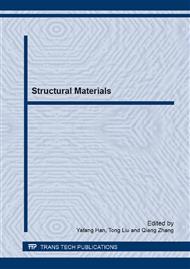p.334
p.340
p.346
p.351
p.357
p.362
p.367
p.372
p.378
Effect of Strain Induced Martensite for 304M2 Austenitic Stainless Steel Wire
Abstract:
The impact of deformation and strain rate on the strain induced martensite (SIM) from 304M2 austenitic stainless steel was studied by using X-Ray diffraction, transmission electron microscopy. The results indicate that 304M2 is easy to have SIM because of the chemical component and microstructural characteristic. The amount of SIM has great relationship with the deformation and strain rate. It is found that the amount of SIM is reduced during high speed deformation. The obvious SIM can be observed with higher deformation, but the growth rate slows down. When the deformation rates are 8.3%, 55.0% and 67.3%, the contents of martensite are 6.55%, 15.35% and 16.21%, respectively. Compared with the slow stretching, the quick stretching leads to less martensite transformation. Moreover, the elongation of the specimens decreases. At the stable deformation stage, the temperature increases are 72.8 and 91.9℃, respectively, when the strain rates are 2×10-2s-1 and 5×10-4s-1. Therefore, the martensitic transformation and the deformation behavior of the austenitic stainless are affected by heating.
Info:
Periodical:
Pages:
357-361
Citation:
Online since:
April 2014
Authors:
Price:
Сopyright:
© 2014 Trans Tech Publications Ltd. All Rights Reserved
Share:
Citation:


